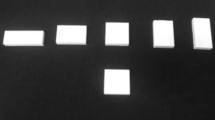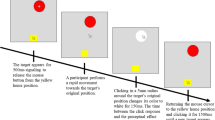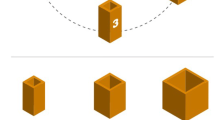Abstract
The present study was aimed at investigating whether the execution of a sequential action changes when the temporal contiguity between the motor steps composing it is altered. Participants were requested to reach and grasp an object and pour its contents into a container under two conditions: a ‘fluent pouring’ condition in which participants were instructed to execute the action fluently and an ‘interrupted pouring’ condition in which participants were instructed to reach and grasp the object, wait for an acoustic signal and then complete the pouring action. A ‘control’ condition in which participants were requested to reach and grasp the object without performing any subsequent action was also administered. Results indicate that movement duration and hand kinematics varied depending on the temporal relationship between the reach-to-grasp and the lift-to-pour phases. When a delay at object contact was introduced, reach duration was longer and the thumb/index abduction angle was greater than when such a delay was not introduced. These results are interpreted in light of ‘internal model’ theories suggesting that a strict temporal contiguity between the motor steps composing an action is a prerequisite for a skilful movement to be planned and executed.


Similar content being viewed by others
References
Ansuini C, Giosa L, Turella L, Altoè G, Castiello U (2008) An object for an action, the same object for other actions: effect on hand shaping. Exp Brain Res 185:111–119
Armbrüster C, Spijkers W (2006) Movement planning in prehension: do intended actions influence the initial reach and grasp movement? Motor Control 10:311–329
Bernstein N (1967) The coordination and regulation of movements. Pergamon Press, Oxford
Birznieks I, Jenmalm P, Goodwin AW, Johansson RS (2001) Encoding of direction of fingertip forces by human tactile afferents. J Neurosci 21:8222–8237
Blakemore SJ, Wolpert DM, Frith CD (1998) Central cancellation of self-produced tickle sensation. Nat Neurosci 1:635–640
Engel KC, Flanders M, Soechting JF (1997) Anticipatory and sequential motor control in piano playing. Exp Brain Res 113:189–199
Flanagan JR, Bowman MC, Johansson RS (2006) Control strategies in object manipulation tasks. Curr Opin Neurobiol 16:650–659
Gentilucci M, Negrotti A, Gangitano M (1997) Planning an action. Exp Brain Res 115:116–128
Hollerbach JM (1981) An oscillatory theory of handwriting. Biol Cybern 39:139–156
Johansson RS, Westling G (1987) Signals in tactile afferents from the fingers eliciting adaptive motor responses during precision grip. Exp Brain Res 66:141–154
Johnson-Frey SH, McCarty ME, Keen R (2004) Reaching beyond spatial perception: effects of intended future actions on visually guided prehension. Vis Cogn 11:371–399
Kawato M (1999) Internal models for motor control and trajectory planning. Curr Opin Neurobiol 9:718–727
Kent RD, Minifie FD (1977) Coarticulation is recent speech production models. J Phon 5:11–133
MacNeilage PF (1980) Speech production. Lang Speech 23:3–22
Marteniuk RG, MacKenzie CL, Jeannerod M, Athenes S, Dugas C (1987) Constraints on human arm movement trajectories. Can J Psychol 41:365–378
Soechting JF, Flanders M (1992) Organization of sequential typing movements. J Neurophysiol 67:1275–1290
Sosnik R, Hauptmann B, Karni A, Flash T (2004) When practice leads to co-articulation: the evolution of geometrically defined movement primitives. Exp Brain Res 156:422–438
Sternberg S, Monsell S, Knoll RL, Wright CE (1978) The latency and duration of rapid movement sequences: comparisons of speech and typewriting. In: Stelmach GE (ed) Information processing in motor control and learning. Academic Press, New York, pp 118–152
Terzuolo CA, Viviani P (1980) Determinants and characteristics of motor patterns used for typing. Neuroscience 5:1085–1103
Viviani P, Terzuolo CA (1983) The organization and control of movement in handwriting and typing. In: Butterworth B (ed) Language production, vol 2. Academic Press, London, pp 103–146
Wolpert DM, Kawato M (1998) Multiple paired forward and inverse models for motor control. Neural Netw 11:1317–1329
Acknowledgments
We would like to thank Dean Lusher and Jonathan Daisley for their comments on an earlier version of the manuscript. This work was supported by a research grant from the Italian Ministry of Research (MIUR) to U.C.
Author information
Authors and Affiliations
Corresponding author
Rights and permissions
About this article
Cite this article
Ansuini, C., Grigis, K., Massaccesi, S. et al. Breaking the flow of an action. Exp Brain Res 192, 287–292 (2009). https://doi.org/10.1007/s00221-008-1628-x
Received:
Accepted:
Published:
Issue Date:
DOI: https://doi.org/10.1007/s00221-008-1628-x




